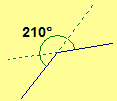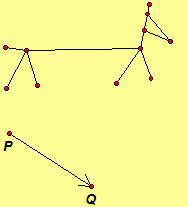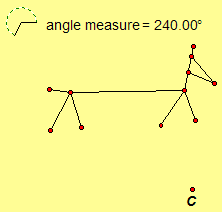3.4.1 Translations
and Rotations
![]() Printout
Printout
By three methods we may learn
wisdom: First, by reflection, which is noblest; Second, by imitation, which is
easiest; and third by experience, which is bitterest.
—![]() Confucius (551–479 B.C.)
Confucius (551–479 B.C.)
Definition. A translation through a vector PQ is a transformation of a plane, denoted TPQ, such that if TPQ maps X to X', then the vector XX' = PQ.
Definition. A rotation about a point C through an angle with measure ,
denoted
,
is a transformation of a plane where C
is mapped to itself and for any point X
distinct from C if
maps X
to X', then d(X', C) = d(X,
C) and
.
C is called the center of the rotation.
By convention, the angle rotation is considered
to be a counter-clockwise rotation.
 Also, angle measure is extended to any real
number value by use of the Supplement Postulate and Angle Addition Postulate.
As illustrated in the diagram, the 210° angle is formed from the sum of 30°,
150°, and 30° angles by use of vertical angles and the axioms. The reader
should be able to justify the extension process from the axioms.
Also, angle measure is extended to any real
number value by use of the Supplement Postulate and Angle Addition Postulate.
As illustrated in the diagram, the 210° angle is formed from the sum of 30°,
150°, and 30° angles by use of vertical angles and the axioms. The reader
should be able to justify the extension process from the axioms.
Definition. A transformation f is a symmetry of a point set if and only if the point set is invariant under the transformation.
Examples. An infinite linear list of circles …O O O O O O O… has translation symmetry. What is a translation vector for this list? A square has four rotation symmetries: rotations of 0°, 90°, 180°, and 270° about the center of the square.
Investigation Exercises. Is each transformation an isometry? If yes, is it a direct or indirect isometry?
3.46. Draw a right
triangle with right angle at C. Accurately draw its image under each transformation.
(a)
TAC
(b)
TAM where M
is the midpoint of .
(c)
RA,90
(d) RC,150
3.47. Draw the image of each transformation (a) TPQ (b) Rc,240 .


Click here to investigate
dynamic illustrations of the above
diagrams with
GeoGebra html or
JavaSketchpad.
3.48. Complete the table of the compositions of rotation symmetries for an equilateral triangle. An animation sketch is available for Geometers Sketchpad in Geometers Sketchpad and GeoGebra Prepared Sketches and Scripts.
|
|
I = RO,0 |
RO,120 |
RO,240 |
|
I = RO,0 |
|
|
|
|
RO,120 |
|
|
|
|
RO,240 |
|
|
|
Is the set of rotation symmetries of an equilateral triangle a group? Explain.
3.49. Complete a table of the compositions of the
rotation symmetries for a square. Is the set of rotation symmetries of a square
a group? Explain.![]()
Theorem 3.11. A translation of a Euclidean plane is an
isometry.
Proof. Let
TPQ be a translation of a
Euclidean plane. Let X and Y be two distinct points in the plane
and X' = TPQ(X) and Y' = TPQ(Y). By
the definition of a translation, are congruent and parallel. Two cases are
possible: either X, X', Y, and Y' are not collinear or they are
collinear.
Assume X, X', Y, and Y' are not
collinear. Since are congruent and parallel, the quadrilateral XX'Y'Y is a parallelogram. Hence, XY = X'Y'.
Assume X, X', Y, and Y' are
collinear. Suppose the points are in the order X, Y, X', Y'. Then by betweenness of points and substitution, XY = XX' – YX'
= YY' –
X'Y = X'Y'. The subcases for other orders of the points are similar.
In both cases XY = X'Y' for any two
distinct points X and Y. Therefore, TPQ is an
isometry.//
Theorem 3.12. A nonidentity translation has no
invariant points.![]()
Theorem 3.13. The set of translations of a plane is a group under composition.
Theorem 3.14. There exists a unique translation mapping X to Y for any two distinct points X and Y in a Euclidean plane.
Theorem 3.15. Let P and Q be two distinct points in a Euclidean plane. Line
and all lines parallel to line
are invariant under the translation TPQ.
No other lines are invariant.
Proof. Let P
and Q be two distinct points in a
Euclidean plane. By Theorem 3.14, there exists a unique translation TPQ.
First, we show the line PQ is invariant. Let X be a point on the
line PQ. Then the line XX' is parallel to the line PQ
where X' = TPQ (X). If X' is not on line PQ,
then the line XX' would intersect the line PQ at X, which
contradicts that the lines XX' and PQ are parallel. Hence, X'
is on line PQ. Therefore, line PQ is invariant under TPQ.
Let l be any line parallel to line
PQ. Let X be any point on l and X' = TPQ
(X). By the definition of translation, lines XX' and
PQ are parallel. By the Euclidean Parallel Postulate, l and XX'
are the same line. Since every point on line l maps to a point on
line l, l is invariant under TPQ.
We need to show there are no other lines that
are invariant under TPQ. Suppose line l is invariant under
TPQ
and is not parallel to line PQ. Then l and line PQ intersect
at some point X. Hence, X is on two invariant lines l and
PQ. Hence, the image point X' = TPQ(X) is on both
lines. Since the two lines are distinct, we must have X = X',
i.e., X is an invariant point under TPQ. But this
contradicts Theorem 3.12. Hence, no other lines are invariant under TPQ.//
Exercise 3.50. Verify other subcases in Case 2 of the proof of Theorem 3.11.
Exercise 3.51. Prove Theorem 3.12.
Exercise 3.52. Prove Theorem 3.13.
Exercise 3.53. Prove Theorem 3.14.
Theorem 3.16. A rotation of a Euclidean plane is an isometry.![]()
Proof. Let be a rotation of a Euclidean plane where C is the center. Let X and Y be two distinct points in the plane and
and
.
Either the points C, X, and Y are collinear or noncollinear.
Assume C, X, and Y are collinear.
Suppose C = X. Then by definition of ,
XY = CY = CY' = XY'. The case for C = Y is similar. Suppose
X is between C and Y. By the
definition of
,
CX = CX' , CY = CY' and
Since C-X-Y
and
,
and C-X'-Y'.
Hence, by substitution and
betweenness of points, XY = CY
CX =
CY'
CX'
= X'Y'.
 The cases for other orders
are similar.
The cases for other orders
are similar.
Assume C, X, and Y are
noncollinear. Then by definition of ,
,
,
and
Similar to the argument using betweenness of
points, we have by substitution and
angle addition that
(Note that several cases must be considered; the
details are left for Exercise 3.54.) Hence, by SAS,
Therefore, XY
= X'Y'.
In all of the cases, XY = X'Y'
for any two distinct points X and Y; therefore, is an isometry.//
Theorem 3.17. A nonidentity rotation has exactly one invariant point.
Theorem 3.18. The set of rotations with center C of a plane is a group under composition.
Exercise 3.54. (a) Verify the case where C is between X and Y in the proof of Theorem 3.16. (b) Verify the angle congruence for each case when the points were assumed to be noncollinear in the proof of Theorem 3.16.
Exercise 3.55. Prove Theorem 3.17.
Exercise 3.56. Prove Theorem 3.18.